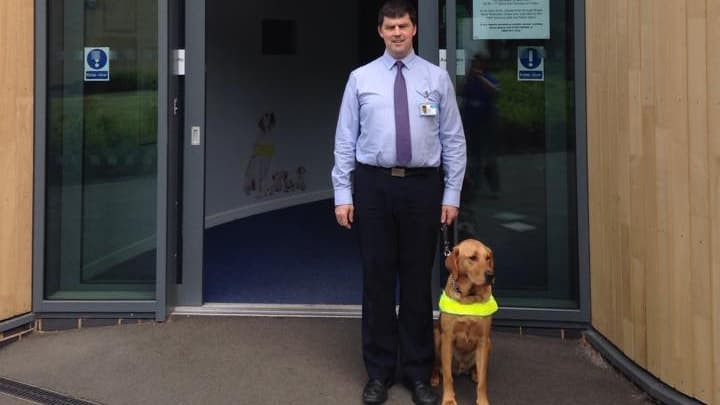
My dog gives me freedom
Empowering blind or partially-sighted people has been the mission of UK charity Guide Dogs since it launched in 1934. We talk to guide dog user John Garrett and Samantha Aarvold, Head of Financial Control about how the charity’s innovative partnership with Barclays allows it to “actively make the world a more accessible place”.
“I first lost my sight when I was 23,” says John Garrett, a Volunteering Consultant at Guide Dogs, who went blind more than 25 years ago. “When it happened I literally thought the bottom had dropped out of my world.”
His experience is all too common, and one that the charity works tirelessly to combat. Since Barclays has partnered with Guide Dogs together they have created a number of groundbreaking initiatives to help improve the lives of blind and partially sighted people.
Before Garrett had a guide dog, when he just had a stick to support him, he would worry about hurting himself – which left him feeling fragile and vulnerable. For Garrett, the stick symbolised fear and all the things he couldn’t do or make sense of. With a guide dog he had the freedom to go wherever he wanted – a friend to face obstacles with. “It’s just a question of holding onto his handle and trusting him,” explains John. “Put simply, my dog gives me freedom.”

For Guide Dogs, a key reason for moving our banking to Barclays was that strong sense that both organisations actively want to make the world a more accessible place
Guide Dogs envisages a world in which blind and partially sighted people have the same mobility and ease of access to all environments as sighted people do. Barclays’ passion for helping those with disabilities – and inclusion in general – made it the logical choice of bank for the charity to partner with.
“For Guide Dogs, a key reason for moving our banking to Barclays was that strong sense that both organisations actively want to make the world a more accessible place for people, regardless of any particular issues they might have,” says Samantha Aarvold, Head of Financial Control at the charity. “Their transition team also ensured the whole move ran smoothly and was an entirely positive experience.”
Alan Bark is a Relationship Director at Barclays. Of his thirty-or-so clients, a third are large charities. Together with his team, he works hard to understand his clients’ challenges – and how the bank can help them. “The first thing we discussed was how we could help Guide Dogs receive fundraising and donations in a more efficient way – for example, donations through Barclaycard,” he explains.
And there are many other ways in which Barclays is able to assist the charity and others it works with. Technology, for example, plays an integral role. Whether it’s offering cash machines with headphone jacks for customers to plug into, or high visibility debit and credit cards to help partially sighted people identify which way round to insert them, the bank works hard to create an environment that is open to all.
Turn the light on and the room somehow feels a safer place, a warmer place. For me, my guide dog Khan is a light in my dark world
It’s a relationship that works both ways. Guide Dogs has provided Barclays staff with in-branch training to ensure they are aware of the different mobility and accessibility needs of the blind or partially sighted bank user. This way, they can make a visually impaired person going into a branch feel like anyone else going in.
“Many of our volunteers are also blind or partially sighted themselves,” says Aarvold. “An awful lot of the funds being paid in are coins so potentially heavy and they need counting. There are very specific issues. So a lot of the work we’re doing with Barclays is around the specific relationships at local branch banking level.”
It’s hard to overestimate the positive impact of a guide dog. Apart from the emotional support it provides, it also gives people their personal independence back, which in turn frees them up to have normal relationships with their partner, close family member or friend, who would otherwise have been their carer.
Bark and his team are proud of their part in supporting this process. “You’ll see a guide dog in the street and knowing how much effort has gone into training that dog and to matching it with the right visually impaired person is fantastic,” he says. “To be able to support that from a banking perspective by helping the charity grow is really rewarding.”
“Being blind is like being in a dark room with no light,” explains Garrett. “Turn the light on and the room somehow feels a safer place, a warmer place – a place of possibilities. For me, my guide dog Khan is a light in my dark world.”
.full.high_quality.jpg)
Turn the light on and the room somehow feels a safer place, a warmer place. For me, my guide dog Khan is a light in my dark world